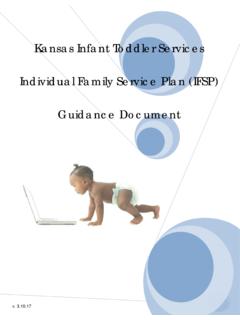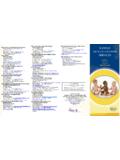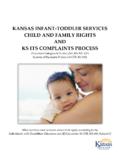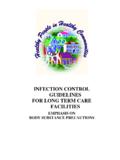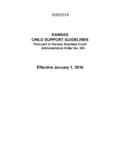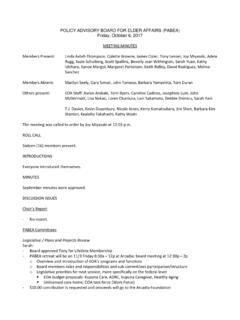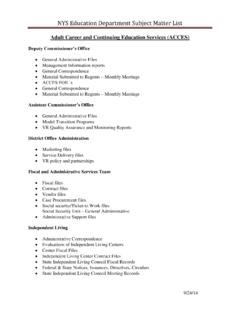Transcription of Kansas - ksits.org
1 Kansas Part C infant/toddler tiny-k Hearing Screening guidelines and Resource Manual Acknowledgements Part C infant/toddler tiny-k Hearing Screening guidelines and Resource Manual is the result of the efforts of people who have been unceasingly dedicated to the early identification and intervention of children with hearing loss. Expertise and time have been generously shared to develop these guidelines .
2 Members of the SoundBeginnings Newborn Hearing Screening Program and Part C Infant Toddler Services unanimously agreed on the purpose of the guidelines : to provide rationale and process for screening hearing of the birth to three population referred for early intervention in Kansas . The final product provides purpose and direction for the many individuals and groups who value and are involved in the detection and intervention of infants and toddlers in the state of Kansas . A special note of appreciation is given to Liz Abbey, SoundBeginnings Coordinator/Audiologist who guided the development of this document.
3 We thank the many people statewide, including members of the SoundBeginnings Advisory Committee, who reviewed the drafts of the guidelines and provided thoughtful input. Date published: June 1, 2010 Revised December 1, 2014 ii Introduction It is important to identify hearing loss early and provide timely intervention for very young children and their families. Early identification prevents delays, for all hearing loss, mild to profound. Research shows if a child receives early identification before 3 months and intervention before 6 months of age, children with hearing loss have language development that is comparable to peers their age.
4 2-3 babies per 1,000 births per year in Kansas will be diagnosed with some degree of hearing loss. The purpose of this manual is to provide standardized hearing screening procedures for all Kansas children receiving services through Part C infant/toddler tiny-k services. The target population for screening is all children birth to three years of age in Kansas . Kansas enacted legislation, effective July 1, 1999, to provide screening for the early detection of hearing loss in all babies born in Kansas hospitals.
5 The Kansas Part C infant/toddler tiny-k Hearing Screening guidelines and Resource Manual does not address newborn hearing screening prior to hospital discharge or assessment. The procedures in this document were written to be used as a training manual and a resource for Part C infant/toddler tiny-k networks that screen hearing in children birth to three years of age. After training is completed Hearing Screening technicians are then able to conduct hearing screenings and identify children who need further testing.
6 Hearing Screening technicians should adhere closely to these procedures and make appropriate referrals to audiologists or physicians when children meet referral criteria to provide the best possible services to their targeted population. iii Table of Contents Introduction Chapter I HEARING SCREENING TECHNICIAN REQUIREMENTS .. 1 A. DEFINITION AND TRAINING REQUIREMENTS .. 1 1. Hearing screening technician .. 1 2. KDHE Programs .. 1 a. Sound Beginnings b. Infant Toddler Service B.
7 TRAINING .. 1 1. Initial Training .. 2 2. Competencies .. 2 3. Renewal .. 3 Chapter II PREPARATION FOR HEARING SCREENING .. 4 A. EQUIPMENT AND SUPPLIES NEEDED .. 4 B. LOCATIONS FOR HEARING SCREENING .. 4 C. EQUIPMENT CHECK AND MAINTENANCE .. 4 1. Daily Listening Check .. 5 2. Calibration .. 5 3. Daily Check of Tympanometer .. 5 4. Maintenance of Equipment .. 5 a. Otoscope b. OAE c. Tympanometer D. INFECTION CONTROL AND UNIVERSAL PRECAUTIONS .. 6 1. Contaminant Exposure .. 6 2.
8 Controlling Contaminant Exposure .. 6 3. Disinfecting Tympanometer Probe Tips and Non-Disposable Otoscope Specula .. 6 4. Best Practices for Contaminant Control .. 6 Chapter III SCREENING PROCEDURES AND PROTOCOLS .. 8 A. PAPER SCREEN .. 8 B. VISUAL INSPECTION .. 9 1. Positioning the Child .. 9 2. Examination Procedure .. 9 3. What Are We Looking For .. 10 4. When to Refer .. 10 C. OTOACOUSTIC EMISSION .. 11 iv 1. Procedure for Conducting OAE Screenings .. 11 2. Poor Test Technique.
9 12 3. Noise .. 12 4. Middle Ear Involvement .. 13 5. Obstructions .. 13 6. Cochlear Outer Hair Cell Loss .. 13 D. TYMPANOMETRY SCREENING .. 14 1. Parameters of Tympanometry Screening .. 14 a. Physical Volume b. Compliance 2. Reliability .. 16 3. Procedure for Conducting Tympanometry .. 16 4. Special Considerations .. 18 5. What We Are Looking For .. 18 CHAPTER IV HEARING SCREENING PROTOCOLS .. 19 CHAPTER V IMPACT OF HEARING LOSS ON INFANTS AND TODDLERS 20 A. IMPACT OF HEARING LOSS ON INFANTS AND TODDLERS.
10 20 B. OTITIS MEDIA .. 20 C. FREQUENTLY ASKED QUESTIONS .. 21 APPENDICES OAE HEARING SCREENING FORM .. 23 RISK INDICATORS FOR HEARING LOSS CHECKLIST .. 24 Spanish Version .. 25 DEVELOPMENTAL SCALES .. 26 Spanish Version .. 27 v Chapter One Hearing Screening Technician Requirements A. DEFINITION AND TRAINING REQUIREMENTS 1. Hearing Screening Technician is defined as any Part C infant/toddler tiny-k employee trained by a Kansas licensed Audiologist to do hearing screening.
